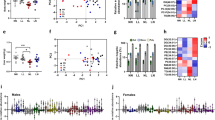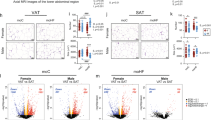Abstract
Background:
Maternal genotype has lifetime effects on progeny, but few specific genes, and no proteases, are known to underlie maternal effects. Prolyl endopeptidase (PREP) is a serine protease with putative substrates that regulate appetite or milk production.
Objective:
To test effects of PREP on obesity phenotypes in mice.
Design:
Mice with a gene trap (GT) of PREP (PREPgt/gt) on the C57BL/6J (B6) background were generated. Minimal PREP protein was detected by western blot. In Experiment 1, direct effects of PREP were measured in littermate mice derived from intercrosses of heterozygotes (PREPWT/gt). In Experiment 2, maternal effects of PREP were measured in reciprocal crosses of heterozygous (PREPWT/gt) and wild-type (WT) (PREPWT/WT) males and females.
Diets:
Mice were fed either low-fat (LF, Experiments 1 and 2) or high-fat (HF, Experiment 1) defined diets.
Measurements:
Adiposity index (AI) was calculated from body weight (BW) and weights of four fat depots measured in 120-day-old mice. Fasting plasma glucose, insulin and leptin were measured. In vivo plasma α-MSH levels were measured by targeted quantitative peptidomics.
Results:
Experiment 1—In intercross mice, there were significant diet effects, but few genotype effects. There were no genotype effects on BW or AI in males or females on either diet. Experiment 2—In contrast, reciprocal crosses of heterozygous males or females with WT B6 revealed highly significant parent of origin effects on all traits except body length. Progeny (WT and heterozygous genotypes and both sexes) born to female PREPWT/gt heterozygotes had fat pads that weighed as much as -twofold more at 120 days old than progeny born to male heterozygotes.
Conclusion:
Heterozygosity for PREP GT results in highly significant maternal effects, whereas homozygosity for the PREPgt/gt mutation has a much more limited direct effect.
This is a preview of subscription content, access via your institution
Access options
Subscribe to this journal
Receive 12 print issues and online access
$259.00 per year
only $21.58 per issue
Buy this article
- Purchase on Springer Link
- Instant access to full article PDF
Prices may be subject to local taxes which are calculated during checkout






Similar content being viewed by others
References
Samuelsson AM, Matthews PA, Argenton M, Christie MR, McConnell JM, Jansen EH et al. Diet-induced obesity in female mice leads to offspring hyperphagia, adiposity, hypertension, and insulin resistance: a novel murine model of developmental programming. Hypertension 2008; 51: 383–392.
Lambin S, van Bree R, Caluwaerts S, Vercruysse L, Vergote I, Verhaeghe J . Adipose tissue in offspring of Lepr(db/+) mice: early-life environment vs. genotype. Am J Physiol Endocrinol Metab 2007; 292: E262–E271.
Davison KK, Birch LL . Obesigenic families: parents' physical activity and dietary intake patterns predict girls' risk of overweight. Int J Obes Relat Metab Disord 2002; 26: 1186–1193.
Hager R, Cheverud JM, Wolf JB . Maternal effects as the cause of parent-of-origin effects that mimic genomic imprinting. Genetics 2008; 178: 1755–1762.
Diament AL, Warden CH . Multiple linked mouse chromosome 7 loci influence body fat mass. Int J Obes Relat Metab Disord 2004; 28: 199–210.
Walter R, Shlank H, Glass JD, Schwartz IL, Kerenyi TD . Leucylglycinamide released from oxytocin by human uterine enzyme. Science 1971; 173: 827–829.
Garcia-Horsman JA, Mannisto PT, Venalainen JI . On the role of prolyl oligopeptidase in health and disease. Neuropeptides 2007; 41: 1–24.
Bellemere G, Vaudry H, Mounien L, Boutelet I, Jegou S . Localization of the mRNA encoding prolyl endopeptidase in the rat brain and pituitary. J Comp Neurol 2004; 471: 128–143.
Ohta N, Takahashi T, Mori T, Park MK, Kawashima S, Takahashi K et al. Hormonal modulation of prolyl endopeptidase and dipeptidyl peptidase IV activities in the mouse uterus and ovary. Acta Endocrinol (Copenh) 1992; 127: 262–266.
Maes M, Monteleone P, Bencivenga R, Goossens F, Maj M, van West D et al. Lower serum activity of prolyl endopeptidase in anorexia and bulimia nervosa. Psychoneuroendocrinology 2001; 26: 17–26.
Maes M, Goossens F, Scharpe S, Calabrese J, Desnyder R, Meltzer HY . Alterations in plasma prolyl endopeptidase activity in depression, mania, and schizophrenia: effects of antidepressants, mood stabilizers, and antipsychotic drugs. Psychiatry Res 1995; 58: 217–225.
Mantle D, Falkous G, Ishiura S, Blanchard PJ, Perry EK . Comparison of proline endopeptidase activity in brain tissue from normal cases and cases with Alzheimer's disease, Lewy body dementia, Parkinson's disease and Huntington's disease. Clin Chim Acta 1996; 249: 129–139.
Warden CH, Fisler JS, Shoemaker SM, Wen PZ, Svenson KL, Pace MJ et al. Identification of four chromosomal loci determining obesity in a multifactorial mouse model. J Clin Invest 1995; 95: 1545–1552.
Chiu S, Kim K, Haus KA, Espinal GM, Millon LV, Warden CH . Identification of positional candidate genes for body weight and adiposity in subcongenic mice. Physiol Genomics 2007; 31: 75–85.
Matthews DR, Hosker JP, Rudenski AS, Naylor BA, Treacher DF, Turner RC . Homeostasis model assessment: insulin resistance and beta-cell function from fasting plasma glucose and insulin concentrations in man. Diabetologia 1985; 28: 412–419.
Schaalan M, El-Abhar HS, Barakat M, El-Denshary ES . Westernized-like-diet-fed rats: effect on glucose homeostasis, lipid profile, and adipocyte hormones and their modulation by rosiglitazone and glimepiride. J Diabetes Complications 2009; 23: 199–208.
Herbach N, Rathkolb B, Kemter E, Pichl L, Klaften M, de Angelis MH et al. Dominant-negative effects of a novel mutated Ins2 allele causes early-onset diabetes and severe beta-cell loss in Munich Ins2C95S mutant mice. Diabetes 2007; 56: 1268–1276.
Chen H, Simar D, Lambert K, Mercier J, Morris MJ . Maternal and postnatal overnutrition differentially impact appetite regulators and fuel metabolism. Endocrinology 2008; 149: 5348–5356.
Barrett T, Troup DB, Wilhite SE, Ledoux P, Rudnev D, Evangelista C et al. NCBI GEO: archive for high-throughput functional genomic data. Nucleic Acids Res 2009; 37 (Database issue): D885–D890.
Vasudevan H, Xiang H, McNeill JH . Differential regulation of insulin resistance and hypertension by sex hormones in fructose-fed male rats. Am J Physiol Heart Circ Physiol 2005; 289: H1335–H1342.
Yakar S, Nunez NP, Pennisi P, Brodt P, Sun H, Fallavollita L et al. Increased tumor growth in mice with diet-induced obesity: impact of ovarian hormones. Endocrinology 2006; 147: 5826–5834.
Bellemere G, Morain P, Vaudry H, Jegou S . Effect of S 17092, a novel prolyl endopeptidase inhibitor, on substance P and alpha-melanocyte-stimulating hormone breakdown in the rat brain. J Neurochem 2003; 84: 919–929.
Jenks BG, Verburg van Kemenade BM, Tonon MC, Vaudry H . Regulation of biosynthesis and release of pars intermedia peptides in Rana ridibunda: dopamine affects both acetylation and release of alpha-MSH. Peptides 1985; 6: 913–921.
Perroud B, Alvarado RJ, Espinal GM, Morado AR, Phinney BS, Warden CH . In vivo multiplex quantitative analysis of 3 forms of alpha melanocyte stimulating hormone in pituitary of prolyl endopeptidase deficient mice. Mol Brain 2009; 2: 14.
Wallingford N, Perroud B, Gao Q, Coppola A, Gao X-B, Diament A et al. Prolylcarboxypeptidase regulates food intake by promoting breakdown of α-MSH. J Clin Invest 2009. In press.
Brzoska T, Luger TA, Maaser C, Abels C, Böhm M . Alpha-melanocyte-stimulating hormone and related tripeptides: biochemistry, antiinflammatory and protective effects in vitro and in vivo, and future perspectives for the treatment of immune-mediated inflammatory diseases. Endocr Rev 2008; 29: 581–602.
Xie T, Chen M, Gavrilova O, Lai EW, Liu J, Weinstein LS . Severe obesity and insulin resistance due to deletion of the maternal Gsalpha allele is reversed by paternal deletion of the Gsalpha imprint control region. Endocrinology 2008; 149: 2443–2450.
Dolinoy DC, Weidman JR, Waterland RA, Jirtle RL . Maternal genistein alters coat color and protects Avy mouse offspring from obesity by modifying the fetal epigenome. Environ Health Perspect 2006; 114: 567–572.
Waterland RA, Travisano M, Tahiliani KG, Rached MT, Mirza S . Methyl donor supplementation prevents transgenerational amplification of obesity. Int J Obes (Lond) 2008; 32: 1373–1379.
Sorensen R, Kildal E, Stepaniak L, Pripp AH, Sorhaug T . Screening for peptides from fish and cheese inhibitory to prolyl endopeptidase. Nahrung 2004; 48: 53–56.
Yanai T, Suzuki Y, Sato M . Prolyl endopeptidase inhibitory peptides in wine. Biosci Biotechnol Biochem 2003; 67: 380–382.
Asano M, Nio N, Ariyoshi Y . Inhibition of prolyl endopeptidase by synthetic peptide fragments of human beta-casein. Agric Biol Chem 1991; 55: 825–828.
Park YS, Jang HJ, Lee KH, Hahn TR, Paik YS . Prolyl endopeptidase inhibitory activity of unsaturated fatty acids. J Agric Food Chem 2006; 54: 1238–1242.
Lee SH, Jun M, Choi JY, Yang EJ, Hur JM, Bae K et al. Plant phenolics as prolyl endopeptidase inhibitors. Arch Pharm Res 2007; 30: 827–833.
Tarrago T, Kichik N, Segui J, Giralt E . The natural product berberine is a human prolyl oligopeptidase inhibitor. ChemMedChem 2007; 2: 354–359.
Morain P, Lestage P, De Nanteuil G, Jochemsen R, Robin JL, Guez D et al. S 17092: a prolyl endopeptidase inhibitor as a potential therapeutic drug for memory impairment. Preclinical and clinical studies. CNS Drug Rev 2002; 8: 31–52.
Bellemere G, Vaudry H, Morain P, Jegou S . Effect of prolyl endopeptidase inhibition on arginine-vasopressin and thyrotrophin-releasing hormone catabolism in the rat brain. J Neuroendocrinol 2005; 17: 306–313.
Morain P, Boeijinga PH, Demazieres A, De Nanteuil G, Luthringer R . Psychotropic profile of S 17092, a prolyl endopeptidase inhibitor, using quantitative EEG in young healthy volunteers. Neuropsychobiology 2007; 55: 176–183.
Acknowledgements
This work was supported by a NIH grants R01-DK69978, DK52581 (CHW) and R01-HL075675, R01-HL091333, R21-AT002599, R21-AT002993, R21-AT003645 (PJH) and the American Diabetes Association. We acknowledge the UC Davis Genome Center Proteomics Core for MS quantitative targeted peptidomics work. We also acknowledge Ella Nunez for assistance with the insulin assays.
Author information
Authors and Affiliations
Corresponding author
Rights and permissions
About this article
Cite this article
Warden, C., Fisler, J., Espinal, G. et al. Maternal influence of prolyl endopeptidase on fat mass of adult progeny. Int J Obes 33, 1013–1022 (2009). https://doi.org/10.1038/ijo.2009.129
Received:
Revised:
Accepted:
Published:
Issue Date:
DOI: https://doi.org/10.1038/ijo.2009.129
Keywords
This article is cited by
-
Localization and subcellular distribution of prolyl oligopeptidase in the mouse placenta
Journal of Molecular Histology (2011)



